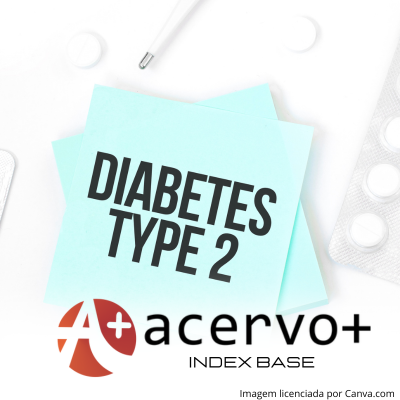Análise in sílico da quercetina como potencial fármaco hipoglicemiante para o tratamento do diabetes tipo 2
##plugins.themes.bootstrap3.article.main##
Resumo
Objetivo: Simular análises farmaco cinéticas e farmaco dinâmicas da quercetina, através de métodos in sílico e relatar seu efeito no combate a hiperglicemia, por meio de revisão de literatura. Métodos: Trata-se de um estudo misto, de natureza descritiva-exploratória e transversal. Os dados foram coletados nas plataformas Swiss ADME e Swiss Target Prediction, ambas disponíveis online e gratuitamente. Nelas foram realizadas análises farmacocinéticas, incluindo interação com enzimas do citocromo P450 e avaliadas as propriedades farmacodinâmicas, com a predição alvos biológicos, respectivamente. Utilizou-se as bases de dados Pubmed e Google Scholar para realização de uma pesquisa bibliográfica analítica sobre os potenciais terapêuticos da quercetina na Diabetes Mellitus tipo 2 (DM2).Resultados: Evidenciou-se boa biodisponibilidade por via oral, cumprindo os parâmetros da Regra de Lapinsk. Demostrou resultados promissores acerca dos parâmetros farmacocinéticos, entretanto apresentou efeito inibitório sobre as proteínas CYP1A2, CYPD6 e CYP3A4. Interagiu com cerca de 100 alvos-biológicos, sendo 33,3% do tipokinase, 6,7% liase,6,7% protease, 6,7% citocromo P450, 13,3% receptor acoplado a proteína G, 13,3% enzima e 20% oxido redutase. Conclusão: Concluiu-se a potencialidade da quercetina para o desenvolvimento de novos fármacos hipoglicemiantes. Entretanto, há maiores necessidades de estudos para avaliar sua terapêutica e a segurança de sua utilização.
##plugins.themes.bootstrap3.article.details##
Copyright © | Todos os direitos reservados.
A revista detém os direitos autorais exclusivos de publicação deste artigo nos termos da lei 9610/98.
Reprodução parcial
É livre o uso de partes do texto, figuras e questionário do artigo, sendo obrigatória a citação dos autores e revista.
Reprodução total
É expressamente proibida, devendo ser autorizada pela revista.
Referências
2. ANKER JVD, et al. Developmental Changes in Pharmacokinetics and Pharmacodynamics. J Clin Pharmacol, 2018; S10-S25.
3. BHATTACHARYA S, et al. Caffeic acid, naringenin and quercetinenhance glucose-stimulated insulin secretion and glucose sensitivity in INS-1E cells. Diabetes Obes Metab, 2003; 602-612.
4. CAIA NARRA e DE FREITAS JCR. Avaliação das propriedades farmacocinéticas de um candidato a fármaco derivado da d-glicose. CONIMAS, 2019.
5. CHEN S, et al. Therapeutic Effects of Quercetin on Inflammation, Obesity, and Type 2 Diabetes. Inflammatory mediators, 2016; 1-5.
6. DARENSKAYA MA, et al. Oxidative stress: pathogenetic role in diabetes mellitus and its complications and therapeutic approaches to correction. Bulletin of experimental biology and medicine, 2021; 171(2): 179-189.
7. EID HM e HADDAD PS. The Antidiabetic Potential of Quercetin: Underlying Mechanisms. Current medicinal chemistry, 2017; 24(4): 355-364.
8. EL KHOURY G, et al. Prevalence, Correlates and Management of Hyperglycemia in Diabetic Non-critically Ill Patients at a Tertiary Care Center in Lebanon. Current diabetes reviews, 2019; 15(2): 133-140.
9. GRAF AB, et al. Rat Gastrointestinal Tissues Metabolize Quercetin. The Journal of Nutrition, 2006; 39-44.
10. GUPTA P, et al. Emerging role of protein kinases in diabetes mellitus: From mechanism to therapy. Advances in protein chemistry and structural biology, 2021; 124: 47-85.
11. GUYOMARD V, MYINT PK. Optimum control of blood glucose for prevention and treatment of ischemic and hemorrhagic stroke. Current treatment options in cardiovascular medicine, 2009; 11(3): 201-11.
12. HAWKINS BT e DAVIS TP. The blood-brain barrier/neurovascular unit in health and disease. Pharmacological reviews, 2005; 173-185.
13. LI Y, et al. Quercetin, Inflammation and Immunity. Nutrients, 2016; 8(3): 167.
14. LIN K, et al. An Interpretable Double-Scale Attention Model for Enzyme Protein Class Prediction Based on Transformer Encoders and Multi-Scale Convolutions. Frontiers in genetics, 2022; 1-20.
15. LUCAS V, et al. Bioactivity of dietary polyphenols: The role of metabolites. Critical Reviews in Food Science and Nutrition, 2019; 1-35.
16. MIRZAEI M. Ciência e engenharia in silico. Adv J Sci Eng, 2020; 1(1): 1-2.
17. MOHO SV, et al. Inhibitory effects of quercetin and its main methyl, sulfate, and glucuronic acid conjugates on cytochrome P450 enzymes, and on OATP, BCRP and MRP2 transporters. Nutrients, 2020; 12(8): 2306.
18. OHDY e OLEFSKY JM. G protein-coupled receptors as targets for antidiabetic therapeutics. Nature reviews Drug discovery, 2016; 15(3): 161-172.
19. OLTHOF MR, et al. Bioavailabilities of quercetin-3-glucoside and quercetin-4'-glucoside do not differ in humans. Human Nutrition and Metabolism—Research Communication, 2000; 1200-1203.
20. OTEIZA PI, et al. Flavonoids and the gastrointestinal tract: Local and systemic effects. Molecular Aspects of Medicine, 2018; 41-49.
21. PAN D, et al. The role of protein kinase C in diabetic microvascular complications. Frontiers in Endocrinology, 2022; 13: 973058.
22. PARDO MR, et al. Bioavailability of magnesium food supplements: A systematic review. Nutrition, 2021; 111294.
23. PATEL RV, et al. Therapeutic potential of quercetin as a cardiovascular agent. European Journal of Medicinal Chemistry, 2018; 889-904.
24. PATEL R, et al. Pharmaceutical Excipients and Drug Metabolism: A Mini-Review. Int J Mol Sci, 2020; 1-21.
25. POET TS e MCDOUGAL JN. Skin absorption and human risk assessment. Chem Biol Interact, 2002; 19–34.
26. RODRIGUES GS, et al. Uso de softwares livres em aula prática sobre filtros moleculares de biodisponibilidade oral de fármacos. Química Nova, 2021; 44: 1036-1044.
27. SERRA CA, et al. Quercetin prevents insulin dysfunction in hypertensive animals. J Diabetes Metab Disord., 2022, 408-417.
28. SIDHU JS, et al. Trends in small organic fluorescent scaffolds for detection of oxidoreductase. Biosens Bioelectron, 2021; 113441.
29. TSAO JP, et al. Short-Term Oral Quercetin Supplementation Improves Post-exercise Insulin Sensitivity, Antioxidant Capacity and Enhances Subsequent Cycling Time to Exhaustion in Healthy Adults: A Pilot Study. Front Nutr, 2022; 9: 1-5.
30. VAN DE WATERBEEMDH e GIFFORDE. ADMET in silico modelling: towards prediction paradise? Nat Rev Drug Discov., 2003; 2(3): 192-204.
31. WANG Y e MA H. Protein kinase profiling assays: a technology review. Drug Discov Today Technol, 2015; 1-8.
32. WEIS WI e KOBILKA BK. The Molecular Basis of G Protein–Coupled Receptor Activation. Annu Rev Biochem, 2018; 897-919.
33. XIE J, et al. Nanomaterial-based blood-brain-barrier (BBB) crossing strategies. Biomaterials, 2019; 1-20.

